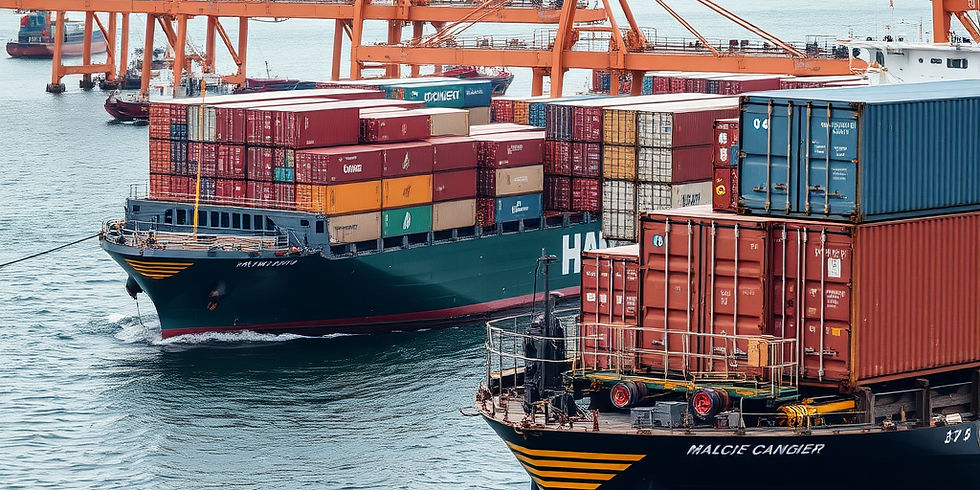Freight Rules, Made Simple: Understanding the NMFC 2025 Update
- Isabelle Miller

- Oct 13
- 4 min read


Freight rules don’t usually make for light reading — but stick with me. This isn’t about drowning in jargon or pages of regulation. It’s about understanding the changes that matter, explained in a way that’s clear, practical, and easy to follow.
By the end of this, you’ll know exactly what the NMFC is, what’s changed in 2025, and how you can use those changes to your advantage.
The freight industry doesn’t stand still, and neither do the rules that guide it. In July 2025, the National Motor Freight Classification (NMFC®) had one of its biggest updates in years — changes that will impact how freight is measured, classified, and billed across the US.
It’s not just carriers and shippers who need to pay attention. These updates affect every link in the supply chain. Let’s explore what’s changed, why it matters, and how businesses can turn this into an opportunity to work smarter.
What is NMFC?
The NMFC is the classification system for less-than-truckload (LTL) shipping. It gives every commodity a class, ranging from 50 to 500, based on four criteria: density, handling, stowability, and liability.
Here’s a simple example:
A pallet of bricks is compact, dense, and easy to handle → lower class, lower cost.
A sofa is large, lightweight for its size, and awkward to stack → higher class, higher cost.
That classification directly shapes how much you’ll pay to move your freight.
Key NMFC Freight Classification Changes in 2025
The July 2025 update to the NMFC made three big changes. Here’s what they mean in plain English:
Density matters more — Density is about how heavy something is for the space it takes up. Imagine two boxes the same size: one filled with nuts and bolts, bricks, or books (dense and heavy), and the other filled with kayaks, or mattresses (big but light). The dense box gets a lower, cheaper class, while the lighter box costs more. Under the new rules, density is now the most important factor in deciding freight class.
More precise scales — Think of it like clothes sizes. Before, there were 11 options, so it was easier to “round up” or “round down.” Now there are 13 sizes, which means things have to fit more exactly. Even small mistakes in measurement can put your freight into the wrong category — and the wrong price.
Updated commodity definitions — The list of freight types has been refreshed. Old, vague descriptions that didn’t match how things are packaged today have been replaced with clearer ones. This makes it harder to misclassify something by accident.
The bottom line? There’s far less room for guesswork. To avoid extra charges or delays, freight now needs to be measured accurately and documented properly.
Why Accurate LTL Freight Measurement Matters More Than Ever
Misclassifying freight can lead to serious issues, including:
Unexpected surcharges when carriers reclassify after pickup.
Overpayment when density is underestimated.
Delays and inefficiencies caused by rework in warehouses or at terminals.
Safety risks if liability or handling requirements aren’t reported correctly.
With the new NMFC rules, relying on guesswork or tape-measure estimates isn’t enough. Precision is now the difference between profit and penalty.
How GPC’s 3D Freight Measure Software Solves NMFC Challenges
At GPC, we’ve designed our 3D Freight Measure software to meet exactly these challenges.
Here’s how our technology helps you stay compliant and efficient:
Instant, accurate measurements: Capture dimensions and volume of parcels, pallets, and irregular freight in seconds—shrink-wrapped or not.
Measure multiple items at once: Eliminate time-consuming manual checks by dimensioning stacked or mixed freight together.
Flexible pallet inclusion: Choose whether to include or exclude pallets in volumetric calculations—crucial when density determines class.
Versatility across environments: Works with handheld devices, forklifts, conveyors, and even in low-light warehouse conditions.
Seamless integration: Push data directly into your WMS or TMS, ensuring quotes, billing, and classifications are always backed by accurate measurements.
Final Thoughts
The NMFC update raises the standard for accuracy across the industry. Shipments now need to be measured precisely, documented clearly, and supported by reliable data. That can sound like extra pressure, but it’s also a real opportunity. Businesses that invest in the right tools and processes will not only avoid penalties and delays but also reduce costs, improve customer confidence, and strengthen relationships.
Accurate measurement isn’t just about compliance — it’s about building a smarter, more resilient operation. And for those ready to adapt, it’s a chance to turn regulation into a genuine competitive edge.
We have the answer, find out more here.
✅ Frequently Asked Questions (FAQ)
1. What is the NMFC?
The National Motor Freight Classification (NMFC) is a standard used in less-than-truckload (LTL) shipping to assign a “class” to every commodity based on density, handling, stowability, and liability. The class determines the shipment’s freight rate.
2. What changed in the NMFC 2025 update?
The July 2025 revision made density the main factor in freight classification, introduced more precise measurement brackets, and refreshed outdated commodity definitions for modern packaging types.
3. Why does density matter so much now?
Under the new rules, denser items — like hardware or bricks — fall into lower, cheaper freight classes, while large but lightweight goods move into higher, more expensive classes. Accurate density calculation is now key to correct pricing.
4. How will the new NMFC rules affect shippers and carriers?
There’s less room for rounding or guesswork. Shipments must be measured and documented precisely to avoid reclassification, billing disputes, or delay charges.
5. How can technology help with NMFC compliance?
Digital dimensioning tools and integrated measurement systems ensure exact data capture, correct class assignment, and smoother billing — turning regulatory compliance into an operational advantage.





Comments